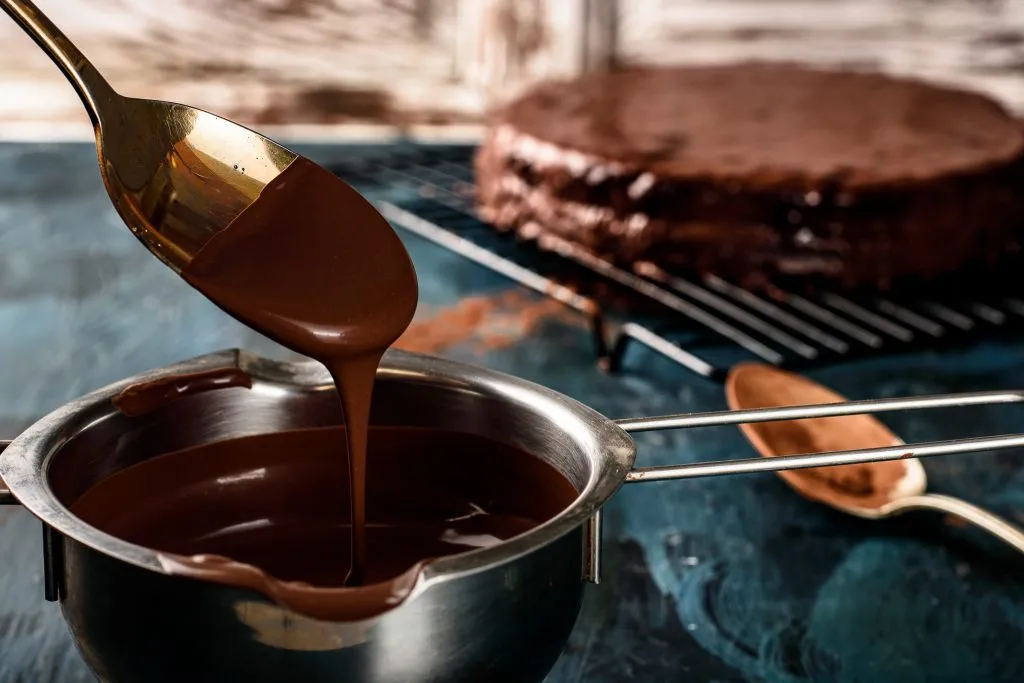Is there more to our food than meets the eyes or we get what we see? Let’s make chocolate glaze and see if our cakes will be the same!

We are all eating with our eyes. Well, not literally except those who experienced pepper sprays or dropped lsd on their eyeballs but the rest of us simply experience food on the old-fashioned way, visually first.
Frostings were made to hide failures and we can’t find better alternatives to plaster up cracks and crevices but to incite true feelings towards our creation, we have to take things a notch higher and this is when glazes come into play.
Mirror glazes aren’t generally used to fix up broken cakes, but they can mend broken relationships if made right.
To make a mirror glaze, first we need to have an even surface that can be achieved by spreading the previously mentioned frosting, jam or just using the flat side of the cake.
The trickiest part of making mirror glaze is the temperature as it has to be poured over the cake when it’s about 86°f / 30°C. If the glaze is colder, we may run the risk of not spreading quickly enough, leaving lumps and bumps along the way. While on the other end of the spectrum if it’s too hot it runs too quickly off the cake leaving almost nothing on top.
Bubbles are a big pain of many while preparing mirror glaze and it’s really heartbreaking to see our perfect cake to be ruined by tiny dots but if we are careful enough at mixing the ingredients, we’ll have none in the glaze when pouring over our precious cake.

Ingredients
Gelatine
- 4 teaspoon Gelatine or 1 Gealtine sheet
- 1 cup Water (for soaking / blooming gelatine)
Chocolate
- ⅔ cup / 150ml Water
- ⅔ cup / 150ml Cream
- ¾ cup / 75g Cocoa powder
- Optional sweetener
How to make Chocolate mirror glaze
Gelatine
- We can use gelatine powder or gelatine sheets, it makes no difference. Soak gelatine (aka bloom) in water until it gets a rubbery consistency.

Chocolate
- Preferably in a double boiler, heat water and dissolve the cocoa powder by slowly stirring it until smooth and lump free. A simple pot on the heater can also be used but mind not to burn the cocoa.

- Once we get a smooth cocoa paste, slowly stir in the cream. Be careful not to create bubbles while stirring. This recipe will result a light colored mirror glaze. For darker glaze just replace parts of the cream or the whole of it with water.

- Dissolve the rubbery gelatine and add any additional sweetener if required.

- Filter the mirror glaze through a fine mashed sieve as a precaution. As we haven’t used chocolate but only cocoa powder it shouldn’t be any hard pieces floating around but it’s better to stay safe then sorry.

- Set it aside and let it cool to 86°F / 30°C. This part is important as too cold glaze will not spread as easily creating bumps and uneven surface while too hot glaze will run off the cake, not leaving thick enough layer to cover the cake.

- Before pouring the glaze on a cake, check for any skin on top of the glaze. We used cream not milk so sometimes there isn’t skin on top but if there is any, just strain the glaze again and then pour it over the cake. Also check for air bubbles and pour the glaze form a low height to prevent the creation of undesired bubbles in the glaze.


Enjoy!


Star this recipe!
Chocolate Mirror Glaze Recipe
Ingredients
Gelatine
- 4 teaspoon Gelatine or 1 Gealtine sheet
- 1 cup Water for soaking / blooming gelatine
Chocolate
- ⅔ cup Water
- ⅔ cup Cream
- ¾ cup Cocoa powder
- Optional sweetener
Instructions
Gelatine
- We can use gelatine powder or gelatine sheets, it makes no difference. Soak gelatine (aka bloom) in water until it gets a rubbery consistency.
Chocolate
- Preferably in a double boiler, heat water and dissolve the cocoa powder by slowly stirring it until smooth and lump free. A simple pot on the heater can also be used but mind not to burn the cocoa.
- Once we get a smooth cocoa paste, slowly stir in the cream. Be careful not to create bubbles while stirring. This recipe will result a light colored mirror glaze. For darker glaze just replace parts of the cream or the whole of it with water.
- Dissolve the rubbery gelatine and add any additional sweetener if required.
- Filter the mirror glaze through a fine mashed sieve as a precaution. As we haven’t used chocolate but only cocoa powder it shouldn’t be any hard pieces floating around but it’s better to stay safe then sorry.
- Set it aside and let it cool to 86°F / 30°C. This part is important as too cold glaze will not spread as easily creating bumps and uneven surface while too hot glaze will run off the cake, not leaving thick enough layer to cover the cake.
- Before pouring the glaze on a cake, check for any skin on top of the glaze. We used cream not milk so sometimes there isn’t skin on top but if there is any, just strain the glaze again and then pour it over the cake. Also check for air bubbles and pour the glaze form a low height to prevent the creation of undesired bubbles in the glaze.
Notes
Pin now, Enjoy later!







